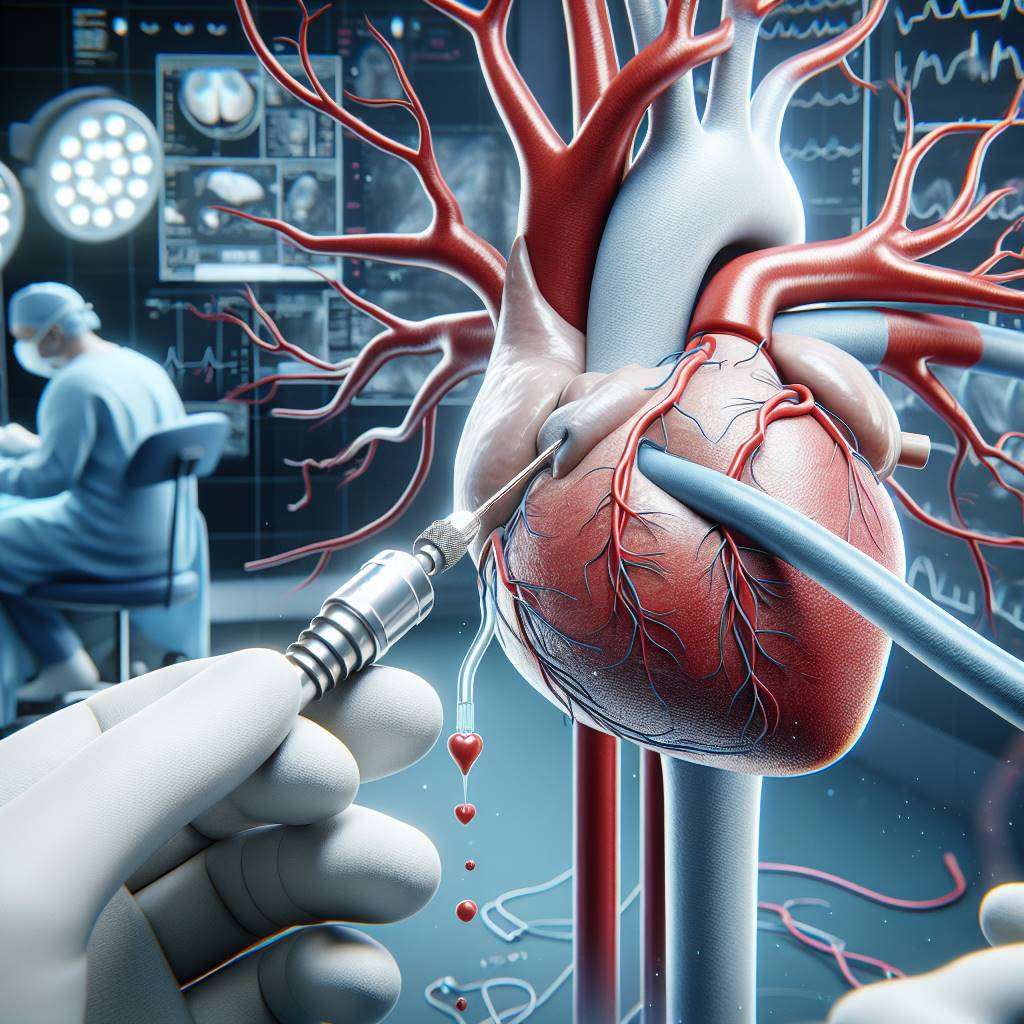Coronary angioplasty is a minimally invasive procedure used to treat blocked or narrowed coronary arteries, which can restrict blood flow to the heart. This treatment is crucial for patients experiencing symptoms of heart disease, such as chest pain or shortness of breath. Understanding the need for angioplasty can help prevent severe complications like heart attacks.
Recognizing the symptoms of coronary artery disease and seeking timely diagnosis is essential for effective treatment. Coronary angioplasty not only restores blood flow but also improves overall heart health. This guide will help you identify key symptoms and understand the diagnostic process to determine if this procedure is right for you.
What Is Coronary Angioplasty and When Is It Needed?
Coronary angioplasty, also known as percutaneous coronary intervention (PCI), is a procedure used to open blocked or narrowed coronary arteries. It involves inserting a thin tube, or catheter, into the artery and inflating a small balloon to widen the passage. In many cases, a stent is placed to keep the artery open and ensure proper blood flow.
This procedure is typically recommended for patients with coronary artery disease (CAD), especially those experiencing severe symptoms like chest pain (angina) or shortness of breath. Angioplasty is also used during emergencies, such as a heart attack, to quickly restore blood flow and minimize damage to the heart muscle.
If left untreated, blocked arteries can lead to life-threatening complications. Consulting a cardiologist for a proper diagnosis is crucial to determine whether angioplasty is the right treatment option for you.

Key Symptoms Indicating You Might Need Angioplasty
Recognizing the symptoms of coronary artery disease early can help prevent serious complications. Some of the most common signs that you might need angioplasty include persistent chest pain, discomfort in the arms, neck, or jaw, and frequent episodes of shortness of breath. These symptoms often occur due to reduced blood flow to the heart.
Other warning signs include fatigue, dizziness, and nausea, especially during physical activity. If you experience these symptoms, it is important to consult a healthcare professional for evaluation. Early diagnosis can help determine whether angioplasty or other treatments are necessary.
- Stable angina: Chest pain that occurs during exertion and improves with rest.
- Unstable angina: Chest pain that occurs unpredictably and may signal a heart attack.
- Shortness of breath: Difficulty breathing, especially during physical activity.
How Chest Pain Could Signal Blocked Arteries
Chest pain, or angina, is one of the most common symptoms of blocked coronary arteries. This pain occurs when the heart muscle does not receive enough oxygen-rich blood due to narrowed or blocked arteries. Angina can feel like pressure, tightness, or a squeezing sensation in the chest.
There are two main types of angina: stable angina, which is triggered by physical activity or stress, and unstable angina, which occurs unpredictably and may indicate a higher risk of a heart attack. If you experience chest pain that lasts more than a few minutes or worsens over time, seek immediate medical attention.
Diagnosing the cause of chest pain often involves tests like an electrocardiogram (ECG), stress test, or coronary angiography. These tests help identify blockages and determine whether angioplasty is needed to restore blood flow.
Understanding Angina: A Warning Sign for Angioplasty
Angina is a key warning sign of coronary artery disease and may indicate the need for angioplasty. It occurs when the heart muscle does not receive enough oxygen due to restricted blood flow. Angina is often described as a feeling of pressure, heaviness, or pain in the chest, but it can also radiate to the arms, neck, or back.
There are different types of angina, including stable angina, which is predictable and occurs during physical exertion, and unstable angina, which is more severe and can occur at rest. Unstable angina is a medical emergency and requires immediate attention.
If you experience frequent or severe angina, your doctor may recommend tests like a stress test or coronary angiography to assess the severity of blockages. Angioplasty is often the next step to relieve symptoms and prevent further complications.
Shortness of Breath: Could It Be Heart Disease?
Shortness of breath, especially during physical activity or while lying down, can be a symptom of heart disease. It occurs when the heart struggles to pump enough blood to meet the body’s needs, often due to blocked or narrowed coronary arteries. This symptom should not be ignored, as it may indicate underlying coronary artery disease.
In addition to shortness of breath, you may experience fatigue, dizziness, or swelling in the legs and ankles. These symptoms can significantly impact your quality of life and may worsen over time without treatment. Consulting a cardiologist is essential to determine the cause and appropriate treatment.
Diagnostic tests like an echocardiogram, chest X-ray, or coronary angiography can help identify the underlying issue. If blockages are detected, coronary angioplasty may be recommended to improve blood flow and alleviate symptoms.
When to See a Doctor for Heart Blockages
Heart blockages can develop silently over time, often without noticeable symptoms until they become severe. It is crucial to consult a doctor if you experience persistent chest pain, also known as angina, which may feel like pressure or tightness in the chest. Other warning signs include shortness of breath, fatigue, dizziness, or pain radiating to the arms, neck, or jaw.
These symptoms may indicate underlying coronary artery disease (CAD), which can lead to serious complications like a heart attack. Early detection and treatment are essential to prevent further damage. If you have risk factors such as diabetes, high blood pressure, or a family history of heart disease, regular check-ups are highly recommended.

Tests to Diagnose If You Need Angioplasty
To determine if you need a coronary angioplasty, doctors rely on a series of diagnostic tests. These tests evaluate the extent of blockages in your coronary arteries and assess the overall health of your heart. Common tests include:
- Electrocardiogram (ECG): Measures the electrical activity of your heart to detect abnormalities.
- Stress Test: Monitors your heart's performance during physical exertion or medication-induced stress.
- Coronary Angiography: A specialized imaging test that uses contrast dye and X-rays to visualize blockages in the arteries.
These tests help doctors decide whether angioplasty is the best treatment option for restoring blood flow to your heart.
How ECG and Stress Tests Detect Heart Issues
An electrocardiogram (ECG) is a quick and non-invasive test that records the electrical signals of your heart. It helps detect irregular heart rhythms, previous heart attacks, and other abnormalities. If your ECG results are abnormal, your doctor may recommend further testing.
A stress test evaluates how your heart performs under physical or chemical stress. During this test, you may walk on a treadmill or receive medication to simulate exercise. The test monitors your heart rate, blood pressure, and ECG changes, helping identify areas of reduced blood flow caused by blockages.
Both tests are essential tools in diagnosing heart conditions and determining whether further interventions, such as angioplasty, are necessary.
Role of Coronary Angiography in Diagnosing Blockages
Coronary angiography is considered the gold standard for diagnosing blockages in the coronary arteries. This minimally invasive procedure involves inserting a catheter into a blood vessel, usually in the wrist or groin, and guiding it to the heart. A contrast dye is then injected, allowing X-rays to create detailed images of the arteries.
The angiography results help doctors pinpoint the location and severity of blockages. Based on these findings, they can decide whether angioplasty or other treatments, such as bypass surgery, are required. This test is particularly useful for patients with severe symptoms or inconclusive results from non-invasive tests.
Risk Factors That May Lead to Angioplasty
Several risk factors increase the likelihood of developing coronary artery disease, which may eventually require angioplasty. These include:
- High cholesterol: Excess cholesterol can form plaques that narrow the arteries.
- Hypertension (high blood pressure): Puts extra strain on the heart and arteries.
- Diabetes: Increases the risk of arterial damage and blockages.
- Smoking: Damages blood vessels and accelerates plaque buildup.
- Obesity: Contributes to high blood pressure, diabetes, and cholesterol issues.
Managing these risk factors through lifestyle changes, medications, and regular check-ups can help reduce the need for invasive procedures like angioplasty.
How Lifestyle Choices Impact Coronary Artery Health
Your lifestyle plays a significant role in maintaining the health of your coronary arteries. Poor habits like smoking, consuming a high-fat diet, and lack of exercise can lead to the buildup of plaque in the arteries, a condition known as atherosclerosis.
On the other hand, adopting a heart-healthy lifestyle can reduce your risk of developing coronary artery disease. Regular physical activity, a balanced diet rich in fruits, vegetables, and whole grains, and avoiding tobacco products are essential steps. Managing stress and maintaining a healthy weight also contribute to better cardiovascular health.
Here are some key lifestyle changes to protect your heart:
- Quit smoking and limit alcohol consumption.
- Engage in at least 30 minutes of moderate exercise daily.
- Monitor and control blood pressure and cholesterol levels.
By making these changes, you can significantly lower your chances of needing procedures like coronary angioplasty in the future.

Difference Between Angioplasty and Bypass Surgery
Both angioplasty and bypass surgery are treatments for blocked coronary arteries, but they differ in approach and complexity. Understanding these differences can help patients make informed decisions about their care.
Angioplasty is a minimally invasive procedure where a catheter with a balloon is used to open blocked arteries. Often, a stent is placed to keep the artery open. It is typically recommended for patients with mild to moderate blockages.
In contrast, bypass surgery is a major surgical procedure where a healthy blood vessel is taken from another part of the body and used to bypass the blocked artery. This is usually advised for severe or multiple blockages.
| Angioplasty |
Bypass Surgery |
| Minimally invasive |
Major surgery |
| Shorter recovery time |
Longer recovery time |
| Suitable for mild blockages |
Recommended for severe blockages |
Consult your cardiologist to determine which treatment is best suited for your condition.
What Happens During a Coronary Angioplasty Procedure?
A coronary angioplasty is a common procedure to restore blood flow in blocked or narrowed coronary arteries. It is performed under local anesthesia, and the patient remains awake during the process.
The procedure begins with the insertion of a catheter into a blood vessel, usually in the groin or wrist. The catheter is guided to the blocked artery using X-ray imaging. Once in place, a small balloon at the tip of the catheter is inflated to widen the artery. In most cases, a stent is placed to keep the artery open permanently.
This minimally invasive procedure typically takes 1–2 hours and has a high success rate. Patients often experience immediate relief from symptoms like chest pain and shortness of breath.
While angioplasty is effective, it is not a cure for coronary artery disease. Long-term lifestyle changes and medications are essential to prevent further blockages.
Recovery and Aftercare Following Coronary Angioplasty
After a coronary angioplasty, proper recovery and aftercare are crucial for long-term success. Most patients can return home within 24–48 hours, but full recovery may take a few weeks.
During the recovery period, patients are advised to avoid strenuous activities and follow their doctor’s instructions regarding medications. Blood-thinning medications are often prescribed to prevent clot formation around the stent. Regular follow-ups with your cardiologist are essential to monitor your progress.
Here are some tips for a smooth recovery:
- Adopt a heart-healthy diet low in saturated fats and cholesterol.
- Engage in light physical activity as recommended by your doctor.
- Quit smoking and manage stress effectively.
By adhering to these guidelines, you can reduce the risk of complications and improve your overall heart health.
Preventing Heart Blockages: Tips for a Healthy Heart
Prevention is always better than cure, especially when it comes to heart blockages. By adopting a proactive approach, you can significantly reduce your risk of developing coronary artery disease.
Start by focusing on your diet. Include plenty of fruits, vegetables, whole grains, and lean proteins in your meals. Avoid foods high in trans fats, sugar, and sodium. Regular exercise, such as walking, swimming, or cycling, can also improve your cardiovascular health.
Other preventive measures include:
- Maintaining a healthy weight.
- Managing chronic conditions like diabetes and hypertension.
- Getting regular health check-ups to monitor cholesterol and blood pressure levels.
By making these changes, you can protect your heart and reduce the likelihood of needing procedures like angioplasty in the future.
Best Coronary Angioplasty Doctors in India
Two of the most reputed doctors for Coronary Angioplasty in India are Dr. Naresh Trehan, Chairman and Managing Director of Medanta - The Medicity, Gurugram, with over 40 years of experience and international recognition, and Dr. Ashok Seth, Chairman of Fortis Escorts Heart Institute, New Delhi, with over 35 years of expertise and numerous global accolades. Both are pioneers in advanced cardiac care.
Learn more on best coronary angioplasty doctors in india
Best Coronary Angioplasty Hospitals in India
Leading hospitals for Coronary Angioplasty in India include Fortis Escorts Heart Institute, New Delhi, a JCI-accredited center known for cutting-edge cardiac care and robotic surgery, and Medanta - The Medicity, Gurugram, an NABH-accredited hospital offering multidisciplinary care and international patient services. Both hospitals have a proven track record of success stories and advanced technologies.
Find more best coronary angioplasty hospitals in india
Coronary Angioplasty Cost in India
The cost of Coronary Angioplasty in India typically ranges from INR 1,50,000 to INR 3,50,000 (approximately USD 1,800 to USD 4,200). Factors influencing costs include the doctor’s expertise, hospital type, and procedure complexity. The average hospital stay is 2-3 days. India offers a significant cost advantage compared to Western countries, with options for medical insurance and third-party financing.
Learn coronary angioplasty cost in india
Coronary Angioplasty Treatment in India
Coronary Angioplasty in India involves inserting a catheter with a balloon to open blocked arteries, often followed by stent placement. Advanced technologies like drug-eluting stents and intravascular imaging are widely used. Recovery typically takes 1-2 weeks. Top hospitals adopt innovations like robotic-assisted angioplasty and adhere to global medical protocols, ensuring high-quality care for international patients.
Learn on Coronary Angioplasty Treatment in India
FAQs
What is Coronary Angioplasty?
Coronary Angioplasty is a minimally invasive procedure to open blocked or narrowed coronary arteries, improving blood flow to the heart. It often involves the placement of a stent to keep the artery open.
Who needs Coronary Angioplasty?
Patients with symptoms of coronary artery disease such as chest pain, shortness of breath, or those who have had a heart attack may require Coronary Angioplasty.
Is Coronary Angioplasty a major surgery?
No, Coronary Angioplasty is a minimally invasive procedure performed under local anesthesia, typically requiring only a small incision in the groin or wrist.
What are the risks of Coronary Angioplasty?
While generally safe, risks include bleeding, infection, blood clots, or re-narrowing of the artery. These risks are minimized with expert care.
How long does it take to recover from Coronary Angioplasty?
Most patients recover within 1-2 weeks, but full recovery depends on individual health and adherence to post-procedure care.
Can Coronary Angioplasty prevent a heart attack?
Yes, by restoring blood flow to the heart, Coronary Angioplasty can reduce the risk of a heart attack in patients with blocked arteries.
What lifestyle changes are needed after Coronary Angioplasty?
Patients should adopt a heart-healthy diet, exercise regularly, quit smoking, and manage conditions like diabetes and hypertension.
How long does a stent last after Coronary Angioplasty?
Modern drug-eluting stents are designed to last for many years, significantly reducing the risk of re-narrowing.
Is Coronary Angioplasty covered by insurance in India?
Yes, most health insurance policies in India cover Coronary Angioplasty. Patients should confirm coverage details with their insurer.
How do I choose the best hospital for Coronary Angioplasty in India?
Look for hospitals with NABH or JCI accreditation, experienced cardiologists, advanced technologies, and positive patient reviews.
Understanding Stent Options and Cost-Effective Angioplasty Solutions
When facing coronary artery issues, selecting the right stent is crucial for effective treatment. Patients often find themselves choosing between drug-eluting stents and bare metal stents. To learn more about these options, check out our detailed guide on stent types explained, which outlines the benefits and drawbacks of each type.
In addition to understanding stent options, managing the costs associated with coronary angioplasty is essential for many patients. There are various strategies to save money on treatment without compromising care quality. For practical tips on how to navigate these expenses, visit our blog on saving money on coronary angioplasty treatment.
By being informed about stent choices and cost-saving measures, patients can make empowered decisions regarding their heart health and financial well-being.